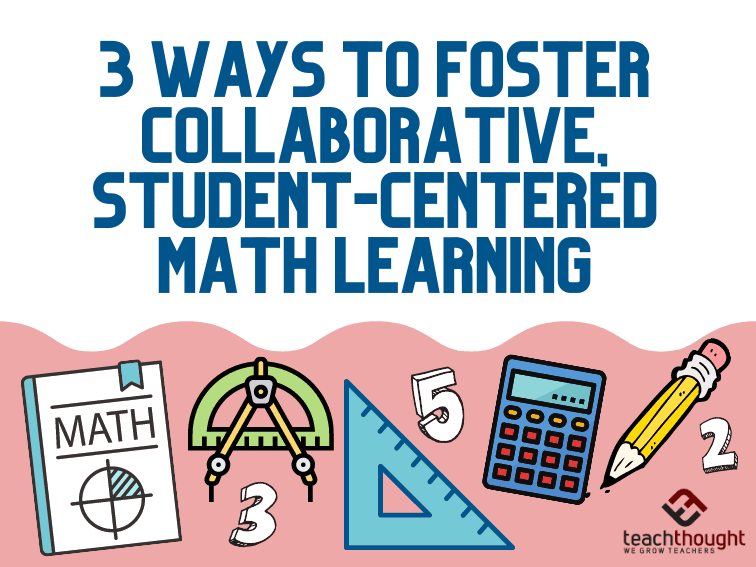
3 Ways To Foster Collaborative, Student-Centered Math Learning
contributed by Sophia Thomas and Evan Weiner
As math educators, we know that math is more than just formulas and calculations.
It’s about finding patterns you never noticed before, proving an idea for the first time, and visualizing the phenomena that make our world amazing. We aim to engage our students in these wonders of math every day, and we do that by using student-centered practices—like discussion and collaboration—in our math classrooms.
In 2019, our team at Leadership Public Schools decided to focus on developing and deepening student-centered math instruction (as opposed to teaching math as merely a set of procedures) as a way to support deeper learning and promote students’ confidence, agency, and identity. This focus on student-centered math instruction led us to adopt Illustrative Mathematics, a highly-rated, openly-licensed math curriculum that takes a student-centered approach. Here are three key strategies that have made a positive impact as we’ve implemented a student-centered math approach and curriculum over the past two years.
Encouraging math talk
Too often, we think of math class as a place where students silently work with their heads down over worksheets. We wanted to turn this notion upside down and encourage students to discuss math concepts with each other. One strategy that’s been helpful in doing this is following the progression of the Illustrative Mathematics curriculum: it starts with accessible, low-stakes tasks and lessons that allow students to feel confident engaging in discussion and asking questions, building towards more sophisticated concepts, procedures, and applications over time. This helps establish “math talk” as a habit that students keep up through the school year and beyond.
For example, the first unit in our 9th grade Algebra I class is focused on one-variable statistics. As a class, they use a Google Form to collect data from each student about the number of people in their household and number of siblings they have, and then they look at the shape of the distribution through graphs. The students get excited about seeing where they fit among their peers and they also can begin to see the broader story the data tells. They start to verbalize their realizations and wonderings, use statistical terms, ask questions and debate the answers with each other. Questions like “How many times can a dog actually bark within a minute?” in a later unit incited a spirited debate among the 9th graders—and it was all prompted by a focus on mathematical talk.
Adapting math tasks to meet students’ needs
Because Illustrative Mathematics is openly licensed, we’re able to customize any part of the curriculum to meet students’ needs, build on the knowledge they bring to the classroom, and cater to their specific interests. In our 10th grade Algebra II class, for instance, we added discussion supports to augment a lesson on the end behavior of polynomial functions, to help our students (many of whom are English Learners) access both the complex language and conceptual thinking at play. We’ve also designed our own tasks in the style of those included in the Illustrative Mathematics curriculum. When we noticed students struggling with the subtleties of sequence definitions, we created a card sort that mirrored similar tasks from the curriculum, but targeted to students’ specific needs matching recursive and nth term sequence definitions. Being able to adapt and customize math content to meet students’ specific needs, through tasks that are both accessible and rigorous, goes a long way in creating more engaged, student-centered classrooms.
Focusing on life skills
Working in groups to solve problems is a skill that every student needs—and one that they’ll use well into the future. A key part of collaborative problem solving is thinking critically about different solutions. Math offers an opportunity for students to not only share how they solved a problem but also explore other approaches to solving it.
In the first unit of Algebra II, we challenge students to write their own geometric sequence. One student wrote “1, 1, 1, 1, 1, …” which prompted a discussion about whether this in fact qualified as a geometric sequence (and later, whether “0, 0, 0, 0, 0, …” also works). While the students explained their reasoning for whether they thought it was a geometric sequence, they used skills like constructing a persuasive argument, citing evidence to back up their point of view, and being empathetic by thinking through someone else’s point of view. Other tasks, like ones where students generalize their understanding of multiplication diagrams to ‘invent’ the idea of polynomial division, push students to solve problems together for which a solution method hasn’t already been modeled or prescribed by a teacher. Importantly, these tasks allow each student to bring their own unique understanding and knowledge to the classroom—a foundational aspect of student-centered learning.
As we recover from the pandemic, we—like so many educators—want to accelerate our students’ learning while also supporting their wellbeing. Student-centered instructional strategies meet both of these goals, and we’ve found that math class is an unexpectedly perfect place to employ them. Coupled with an adaptable, student-centered curriculum like Illustrative Mathematics, these strategies can help students see themselves as capable, confident learners—both inside and outside the math classroom.
Stay connected with us on social media platform for instant update click here to join our Twitter, & Facebook
We are now on Telegram. Click here to join our channel (@TechiUpdate) and stay updated with the latest Technology headlines.
For all the latest Education News Click Here
For the latest news and updates, follow us on Google News.

